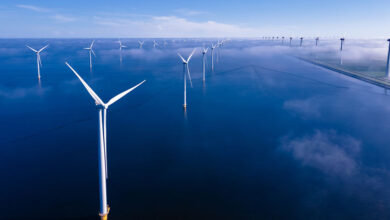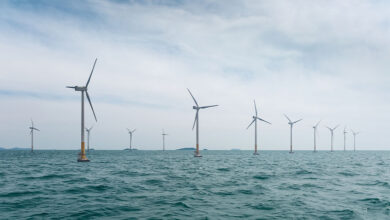John O’Connell interview: Efficient water services
 The Commission for Energy Regulation’s Generation Manager John O’Connell discusses the regulator’s plans for greater efficiencies and customer protection in water services with Stephen Dineen.
The Commission for Energy Regulation’s Generation Manager John O’Connell discusses the regulator’s plans for greater efficiencies and customer protection in water services with Stephen Dineen.
Significant challenges are facing the Commission for Energy Regulation (CER) ahead of regulating water services, not least that it is unfamiliar territory. “We have a good background from regulating the energy sector but obviously there will be unique challenges and issues with water,” John O’Connell tells eolas, “so the first challenge really is to understand.”
The regulator must learn water customers’ needs and “understand how those needs are serviced and delivered upon.” Amalgamating 34 different water services agencies (i.e. those of every city and county council) will be the responsibility of the Department of the Environment, Community and Local Government and Irish Water. O’Connell, though, believes that CER will have to be involved to ensure “an efficient outcome” for customers. “There’s no point in replicating the 34 councils within one semi-state company; it’s not going to deliver the efficiency we want,” he insists.
Communicating to customers “what the cost is, what they’re paying for, why they should pay it” will also be on the regulator’s agenda. O’Connell, who is working on the regulator’s preparations for water regulation, points to the cost of water services: €1.2 billion in 2010 (the most recent figure available). This included €715 million in operating costs and €517 million in capital costs. “We want to go in and look at that figure and see what the efficiencies are that can be achieved by the new programme,” O’Connell states. “We want to make sure that those efficiencies are given to customers, that it’s not squirreled away for the company’s benefit or anything like that.”
Driving efficiency
Efficiency is a theme to which O’Connell keeps returning. While the goal is to ensure that the public water industry delivers clean drinking water and an efficient wastewater system, independent regulation “is the spur that drives efficiency in these monopoly utility companies.” It does this by providing a stable framework in which companies can borrow for investment, ensuring the right investment undertaken with “a long-term plan rather than immediate needs.”
Regulating the price of water, particularly in the longer term, he says, will be based on ensuring that “customers only pay for efficient service.”
The new utility’s customer service will be driven by efficiency, he adds. He gives the example of ESB Networks, the monopoly owner of the electricity grid: “We heavily regulate them to make sure that the response that they give is efficient and delivers the service that the customer needs.”
For incidents of storms, for example, ESB has a system to monitor the network so that if a power outage occurs, an automated phone message is in place for customers, acknowledging the problem and stating an anticipated time of power return. The regulator proposed this.
The regulator will require Irish Water to have a customer charter, providing customer protection and information, service target levels and mandatory codes of practice.
CER will also provide a complaints resolution service, an outlet for customers if their disputes with Irish Water are not resolved. O’Connell believes that this will be a good way for the regulator to get information from customers on service expectations and areas where the utility is failing.
Communicating to the public about what it will try to achieve will also form part of engagement with the public. “You have to make an effort, even if customers don’t want to hear the message,” he says.
“You have to be out there communicating to them: what is the goal of what you’re trying to do and why you’re charging for it. That sort of thing is actually important and will lead to a better outcome ultimately.”
Having regulated the energy sector since 1999, CER hopes to draw upon this experience for its new duties. “There’s good regulatory practice out there,” he reflects. “We have to provide stability so industry can fund itself as cheaply as possible.”
O’Connell knows that water bills (due in 2014) will be seen by most customers “as a new charge”. He and his colleagues will be communicating a simple message: “You will get a world class service that will be there for our children’s children, that it will be sustainable, it won’t lead to degradation in the environment and that you get what you’re paying for.”
He points to an EPA report on water quality between 2007 and 2009. It found that municipal sources such as nutrient loss from wastewater treatment plants accounted for 31 per cent of slightly polluted sites on rivers and canals. “Now that’s not sustainable,” he states. “If we don’t have an environment you can actually physically live in, having low taxes is no good to you.”
Revenue regulation: building blocks of price control
“There’s no point in being erratic and saving the customer €1 today but it’ll cost you €5 tomorrow,” says O’Connell on regulating the industry’s revenue. He believes that “significant need for capital investment in the network” lies ahead.
CER expects to apply the price control model used for the electricity and gas networks here, and by England and Wales’ water regulator Ofwat, to Irish Water. Revenue control frameworks typically last for five years.
The regulator firstly reviews the utility’s submission on expectation of operating expenditure (opex) and capital expenditure (capex). It then challenges these expectations of required funding, infrastructure proposals and questions whether operation measures would be more suitable than capital plans.
Calculating the price control involves adding capital allowances to the regulatory asset base, as well as providing for depreciation of assets, a weighted average cost of capital (i.e. each category of capital expense is weighted) and opex.
The price control incentivises the utility to meet capex and opex targets. If it exceeds the targets, it keeps a proportion of the profit; financial penalties are imposed if the targets are not met.





